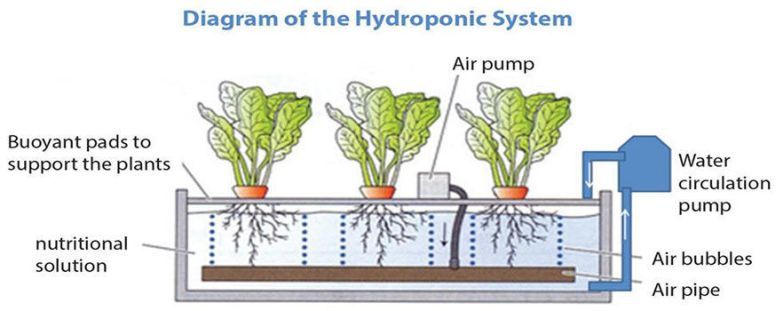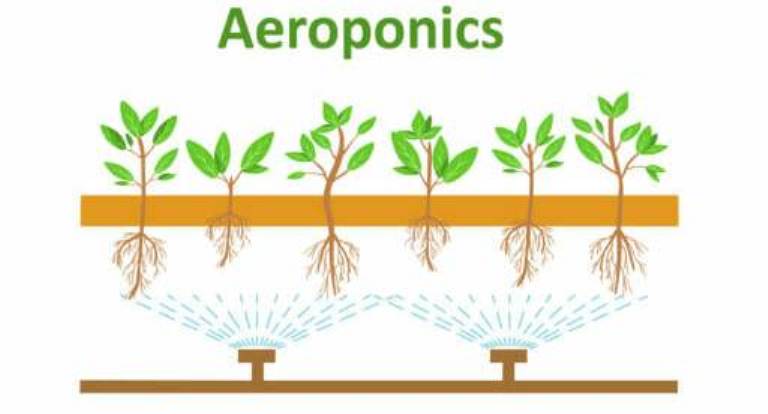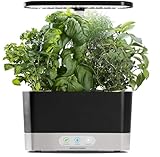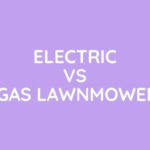There are many methods followed in soil-less agriculture. Some have been big hits and the others haven’t worked well. Aeroponics and hydroponics are two soil-less farming methods that impressed everyone. But many people get confused between them. So let’s dig in and find what is the difference between Aeroponics vs Hydroponics.
Our Verdict
There is major difference when you compare Aeroponics vs Hydroponics. If you want to start to use this professionally, then investing the money is worth it. The issues with power and maintenance should be taken care of. The hydroponics aren’t bad but are worth too much for the money you invest. If you’re a beginner, this would be easier than the aeroponics. If your budget is shorter and you can’t get a continuous power supply, then it’s the better option.
Aeroponics vs Hydroponics: Differences
Other than the process, there are many other differences when comparing Aeroponics vs Hydroponics. If you’re a beginner and wondering which to prefer, this will help you out.
1. Aeration Of Roots
Roots absorb oxygen and release carbon-di-oxide for respiration. This is very important for the plants as it keeps them healthy and strong. If aeration isn’t proper, the plants may face trouble in absorbing nutrients.
The word “aero” itself refers to air. The roots are in the closed chamber which helps it get more air. The roots are also misted with the nutrients and water at correct intervals. This gives the roots of plants under aeroponics better aeration. Hydroponic roots also do the necessary aeration. But the submerged roots don’t give it proper aeration. This makes aeroponics better in this quality.
2. Price
Both of these take a lot of money for setup and maintenance. The initial amount is the key as that is going to affect all the other works. The setup includes setting a closed environment which is the most important. Then, the reservoirs and other needed items like pumps need some money. After that, the price is all about the nutrients.
In this case, aeroponics will cost more than hydroponics. There are a lot of factors which are important in aeroponics. It looks like a simpler plan but a lot of tools must be there to function in a better manner. The hydroponics are cheaper as they aren’t much complex.
3. Spread Of Disease
In hydroponics, the plants are together in the same reservoir. They all receive the same water too. If there’s any chance of water-borne disease, it has high chances of getting spread. This is quite dangerous as we can never predict the disease.
The aeroponics have zero percent of this happening. All the plants are separate and get separate treatment too. This reduces the possibility of spreading. There will be no chance of contact between the plants.
4. Movement Of Plants
Suppose there’s a problem for which needs the plant to separate from others, it gets complex. Hydroponics will find it tough as the plants may be with other plants in the same reservoir. Removing one may affect it and also others too.
Aeroponics won’t have these problems as much as the hydroponics. The movement is quite easier as they all are alone. The problem won’t even arise as they won’t have any medium to get a problem. Even if it comes, the plants won’t have that much problem in movement.
5. Electricity
With the concept of this, it’s clear that both need good electricity backup. The aeroponics rely more on the machines than hydroponics. They have to help with watering and many other things. So even a small problem with the power may have a big effect. There might be problems with the growth and some may even die.
The hydroponics after the initial setup, they don’t have any problems. They also depend on electricity but not as much as the aeroponics. But the aeroponics must need electricity and also a good backup for the best results.
6. Water
Water usage is lesser when compared to our traditional farming methods. But comparing these two, the aeroponics save more water than the hydroponics. In hydroponics, a lot of water is a big need as every nutrient goes to the plant via the water. Recycling takes place but still, a lot of water will get used.
If you won’t have much water supply, then aeroponics are the better choice. They won’t need much like the hydroponics.
7. Yield
The yield is high in both cases compared to the traditional farming methods. The hydroponics as discussed above have a higher possibility of getting a disease. It may be less strong and this may affect the yield. Sometimes, it may also get malnourished as all the plants are in the same reservoir.
The aeroponics will have a higher yield. They will have separate care and proper nutrition. The root of the aeroponics gets more oxygen than the hydroponics. This is because they are alone and absorption of more oxygen is possible. This gives the plant more strength and healthier growth. This increases the yield very well.
8. Bacterial Growth
The hydroponics have more contact with the water. The plants get all the nutrients from the water. Sometimes continuous contact with water may result in bacterial growth. This may start small but will have big side effects later.
Aeroponics are free of this problem as they are in a controlled environment. They don’t need as much water as the aeroponics. Nothing from the outdoor environment can reach the plants. This is very good for the growth of the plants as they won’t have any disturbances.
9. Complexity
Both methods need proper attention for proper results. The aeroponics has a very complex system. This also makes the whole method very sensitive. There should be proper checks and even small errors will affect on a large scale.
The hydroponics have a growing medium where all the plants grow. This doesn’t have a very complex setup. If the water is proper with the required nutrients, the work is almost done.
Aeroponics vs Hydroponics: Farming
Farming without soil was something impossible. But today, it’s a great hit and many households have started doing it. The main concept is delivering the same nutrients which the soil give without the soil. That is by either spraying the required nutrients in any possible manner. This has been a great hit and people who can’t afford lands find it very useful.
These are quite better than our normal methods due to the following factors:
1. Location:
The location is not much important for this process. It could be even set up in your backyard if it satisfies all the needs. In the traditional method, getting a fertile land is such a hectic job.
2. Season Problems:
There is no worry about the seasons or weather. Any plant could be grown anywhere with all the nutrients needed. The yield also increases. This is a great advantage and may help in solving several important problems.
3. Higher Yield
The yield will be quite higher as every plant gets every bit of nutrients it needs. In large land, this may be a problem. Lots of water and nutrients get wasted. This may reduce the cost too
4. No Worries About Disasters
Dangers like floods etc. will never be a problem for the plants. The closed area will prevent it from every damage. There are a lot of techniques to do soil-less farming. Two famous and efficient ones are aeroponics and hydroponics. So let’s find out how do they differ and what are their techniques.
Aeroponics vs Hydroponics: Setup
Hydroponics

This has been developing over the years and is one of the first soil-less methods. This method removes the soil and replaces it with some other efficient medium. Some mediums are:
- Coconut husks
- Gravel
- Perlite
- Coco coir
- Pebbles
- Tubes with required nutrients
The word hydro will tell what the whole process involves. All nutrients for the plants will be from water. It contains almost all the nutrients needed. For other nutrients, they get mixed with water and are then used. This won’t be a problem unless you do any wrong step. Reservoir and many other related materials must be set up correctly. If the setup gets done right, then your outcome will be much better. Good electricity is also an important factor in the process. There should also be a proper study of the plant to be grown. Each plant may have different needs.
Setting Up A Simple Hydroponic System
If you have the money to invest, then it takes some time to set up the hydroponic system. Here are a few steps to help you build a simple hydroponic system
Step 1:
Find out the perfect location with the correct space and temperature. Indoors are much preferable than outdoors. Basements or balconies will do well. If placed outside, Make sure it’s protected from dangers. The lighting should also be good.
Step 2:
Choose the medium in which the plants are going to stay. Let’s assume you have chosen tubes. Drill holes with proper spacing. Get a big tank that stores the water with nutrients. Connect the tank and tubes with pipes to send nutrients. Design it in a way where water gets recycled as it may save a lot of water too.
Step 3:
According to your plants, get the required nutrients and fill the tank with water. Mix the nutrients in the correct amount.
Step 4:
Get the seeds of the plants. It will be better if you get seedlings as it saves more time. Clean up the roots in such a way no soil is leftover in it. After it’s clean, use some pebbles to make the plant stand straight. Anything other than pebbles are also fine but make sure the roots aren’t damaged.
Step 5:
The process is almost over. After this, it’s all about how well it’s monitored. Regular checks should be there to prevent the attack of pests or diseases. Water and nutrients should go at the correct time intervals for better results. The monitoring of plant growth is also very important.
Best Plants For Hydroponics
Now you will be wondering which plants to grow. Here are some ideas to start with. These plants are more ideal for the hydroponic system.
1.Lettuce: They are best to start your hydroponic garden. Their roots are shallow which is a very good advantage. In a month, you could even taste your tasty own lettuces.
2.Spinach: Even other leafy green vegetables are a good choice for a hydroponic system. They need lesser water than normal plants. In about one and a half months, you can get them in the best way.
3.Herbs: Most of the herbs grow well in the hydroponic system. Basil, mint, chives, etc are some examples.
4.Strawberries: If you get the seeds ready, then you can enjoy strawberry at any time. Once you plant it well, you needn’t wait for the season. The water system is quite suitable for the strawberry to grow. It takes around 2 months to get good strawberries.
Aeroponics

Unlike hydroponics, there is no medium here. The plant will be hanging in the air along with the root. The roots will be down in a closed chamber. Time management is the key here. At regular intervals, the chamber gets the required water and nutrients. This gives a faster growth rate too.
The plants as they alone use all the nutrients they get. There is no competition and may give more strength to the plants. This is a very efficient way as each plant gets all the needed nutrients. The setup matters here too. The closed environment will be an added advantage to the yield. There will be no problem in getting a good medium like in hydroponics.
Setting Up An Aeroponic System
The aeroponics is also easy to setup. But this should be set up properly as small errors may affect the plant growth.
Step 1:
The key to this system is the roots hanging in the air. So we should make sure we get a good enclosed chamber. It should be light proof and airtight. It should be in such a way oxygen comes in but nothing inside spills out. It should also hold correct levels of humidity.
Step 2:
The plants above the chamber could be in baskets or any other material like that. But it should be correctly fit above the chamber so the transportation isn’t disturbed. So design it properly.
Step 3:
After these, the rest is all about correct tubing work. The reservoir tank should be big enough to have the nutrients. The tubing should connect the plant and reservoir tank. Excess nutrients should also return to the tank.
Step 4:
The roots sprayed with mist will grow better than the ones sprayed with water. So proper sprinkler heads must be there to make sure the mist gets sprayed well. The timings are also the key for aeroponics. So timers to control the process will make your work easier.
Best Plants For Aeroponics
The plants suitable for hydroponics are also perfect for aeroponics.
1.Tomato: They are one of the best. Aeroponics done to mature tomato vines will be very perfect. We may get the proper vegetable in 30 days.
2.Eggplant: They need good sunlight and warmth. This makes them perfect for aeroponics. The nutrients with a bit more nitrogen would give high yields.
3.Watermelon: Aeroponics are more than perfect for watermelons. If you have the space to grow it t, then you can have watermelons anytime. They need more water and the smaller varieties will be a better option.
4.Leafy vegetables and herbs: They are the best for hydroponics and aeroponics. The nutrient solution should be apt with more potassium. Then, you can get generous yields of them throughout the year.
5.Ginger: They are very apt for aeroponics. If the root in the chamber gets proper attention, then they are like the best plants for aeroponics. The shoots if damaged may result in problems. The sprays to the roots are the only task to do so that the shoot has no damage.
Aeroponics vs Hydroponics: FAQ
If you’re a beginner, it’s better if you have some experienced people with you will understand how Aeroponics vs Hydroponics fares. Here are answers to the frequently asked questions which may help you out.
Are aquaponics and hydroponics the same?
Many people assume both these to be the same. There are a lot of differences. Aquaponics is an advanced method of hydroponics. It uses aquaculture. Aquaculture is the farming of fish. The waste from fish and bacteria acts along with water as the nutrients for plants.
In hydroponics, the nutrients mixed with water get sent to the roots. But it’s not the same in aquaponics. Here the aquaculture products will be the nutrients. Cucumbers and leafy green vegetables are some great plants for aquaponics
When should I change the nutrient solution in the tank?
First, we fill the tank with water. Then adding nutrients would be better. The pH values should be often checked and if any changes, the addition of water can bring it back to normal. Once the water reduces to half the capacity, it’s better to clean the tank and fill it again. The perfect pH values are anything between 5.4-5.9. Adding nutrients may change the value so make sure you do frequent checks. Make sure you recycle the water!
Will there be a difference in taste between soil and soil-less plants?
The pests and fertilizers used in soil may affect the taste of the plants. But in soil-less plants, all the nutrients get supplied straight to the plants. This gives more strength and nutrient value. So, the soil-less plants may be tastier.
Will hydroponics and aeroponics need pesticides?
If you set up everything indoor, then you need not worry about pests. But if it’s outdoor, it will be better if you take precautions. So hygiene must be a great concern.
Even if pests come, then natural pesticides are preferable. They won’t have much effect on the plants. Organic and natural pesticides should be the first choice. Avoiding the chemicals will give a better result.
What is the perfect temperature for aeroponics and hydroponics?
This will be a bit hard to keep in control. Anything between 20-30 degrees will be fine. But proper study of the plant and temperature they live in is mandatory. This will help you identify the temperature it needs to live in.
How can we control the humidity around the plants?
The rooms must have 45-55% relative humidity to grow well. Sometimes you may need to remove humidity. Dehumidifiers are the best solution to this. They help in removing the required moisture from the air. They are long-lasting and also very efficient.
Many people think air-conditioners can replace these dehumidifiers. This is false as they aren’t very efficient. The air conditioners remove moisture from the air but may cool the room more than expected. Dehumidifiers are better in this case.
The Verdict
After comparing Aeroponics vs Hydroponics for all the factors, we could come to various conclusions. But before all that, soil-less farming is quite useful and will be the game-changer in the field of agriculture. But do check out if hydroponics are really better than soil. If you are much interested and would love to farm, now you could do it even in your balconies with these methods. They are way better than our traditional methods. The aeroponics has a slight edge over the hydroponics in many factors. They give a better yield and have less chances of problems.
AeroGarden Harvest with Gourmet Herb Hydroponic - Editor's Choice
Summary
This has been developing over the years and is one of the first soil-less methods. This method removes the soil and replaces it with some other efficient medium. The word hydro will tell what the whole process involves. All nutrients for the plants will be from water. It contains almost all the nutrients needed.




![Best Lawn Tractor Battery In [year] best lawn tractor battery](https://thehemloft.com/wp-content/uploads/2020/08/lawn-tractor-battery-150x150.jpg)


![Best Electric Pole Saw In [year] Best Electric Pole Saw](https://thehemloft.com/wp-content/uploads/2020/07/Best-Electric-Pole-Saw-1-150x150.jpg)
![Best Manual Pole Saw In [year] Best Manual Pole Saw](https://thehemloft.com/wp-content/uploads/2020/07/Best-Manual-Pole-Saw-1-150x150.jpg)
![Best Cordless Pole Saw In [year] Best Cordless Pole Saw](https://thehemloft.com/wp-content/uploads/2020/07/Best-Cordless-Pole-Saw-1-150x150.jpg)

Leave a Reply